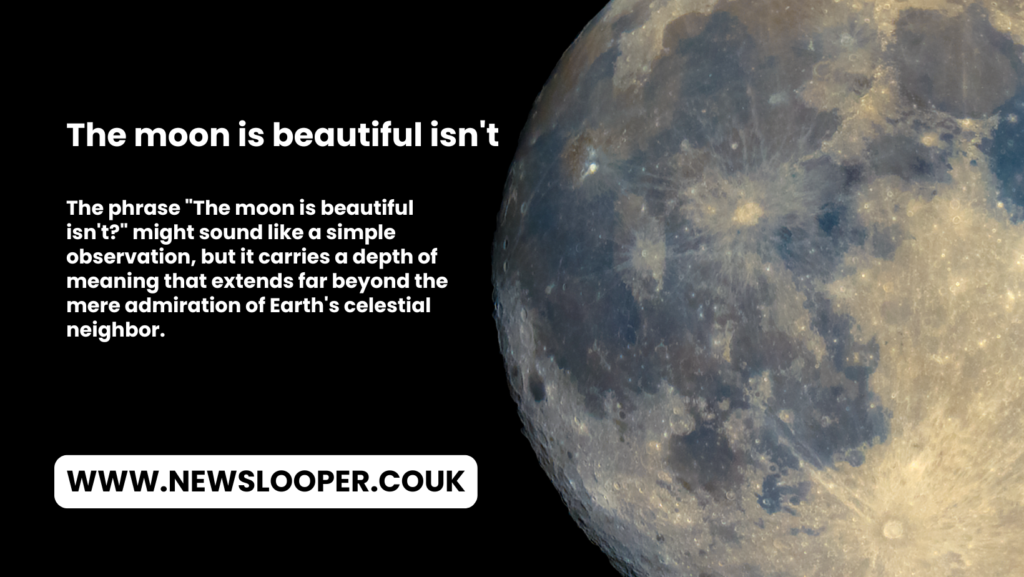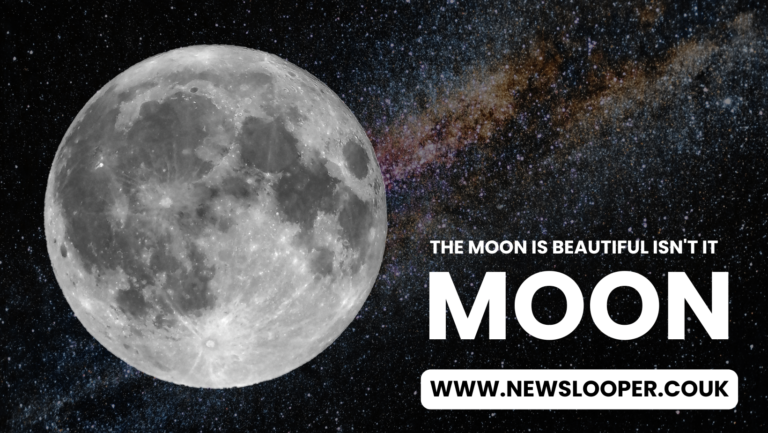The phrase “The moon is beautiful isn’t?” might sound like a simple observation, but it carries a depth of meaning that extends far beyond the mere admiration of Earth’s celestial neighbour. This phrase, rooted in Japanese culture, is a poetic expression and a subtle, romantic way of conveying deep emotions. The elegance and nuance of the statement have made it a timeless phrase that resonates with people across different cultures and languages. In this article, we will explore the origins of this phrase, its cultural significance, and how one might respond when faced with this beautifully crafted sentiment.
Origins and Meaning of “The Moon Is Beautiful, Isn’t It?”
The phrase “The moon is beautiful, isn’t it?” (月が綺麗ですね, Tsuki ga kirei desu ne) is believed to have originated in Japan, credited to the famous Japanese novelist Natsume Sōseki (1867–1916). According to popular legend, Sōseki, a teacher of English, is said to have critiqued a student’s direct translation of the English phrase “I love you” into Japanese. He suggested that rather than using a straightforward and somewhat blunt translation, the student could express the sentiment more poetically and subtly by saying, “The moon is beautiful, isn’t it?”
In Japanese culture, which often values indirectness and subtlety, Sōseki’s suggestion was a way to express love without overt declarations. The phrase uses the moon’s beauty as a metaphor for love, relying on shared understanding and mutual feelings between the speaker and the listener. In its serene and constant presence, the moon represents an unspoken connection, an acknowledgment of beauty that both individuals recognize but do not need to elaborate on.

Cultural Significance and Interpretation
In Japanese culture and many cultures worldwide, the moon holds significant symbolic meaning. It is often associated with beauty, mystery, and the passage of time. The moon’s phases, from the new to the full moon, represent change, growth, and reflection cycles. The moon has frequently been used in literature and poetry as a symbol of unattainable beauty, longing, and deep emotional connection.
The phrase “The moon is beautiful, isn’t it?” taps into this rich symbolism. It is a way of expressing feelings of love, admiration, and deep affection in a poetic and profound manner. Rather than stating “I love you” outright, which might feel too direct or imposing, the speaker invites the listener to share the appreciation of something beautiful. It is an indirect way of saying, “I care for you deeply,” without the need for explicit words.
This indirect form of communication is deeply rooted in the Japanese concept of “animal” (曖昧), which translates to ambiguity or vagueness. Aimai is a cultural preference for avoiding directness in communication, especially in heart matters. By saying, “The moon is beautiful, isn’t it?” the speaker respects the listener’s space and feelings, allowing them to interpret the sentiment and respond as they see fit.
The Moon in Global Symbolism
While the phrase “The moon is beautiful, isn’t it?” is rooted in Japanese culture, the moon’s symbolism as a representation of love, beauty, and mystery is a universal concept. Across various cultures and time periods, the moon has been revered and admired for its beauty and its influence on life on Earth.
In Western literature, the moon often symbolizes romance, melancholy, and the passage of time. It has been a central motif in countless poems, songs, and stories. For instance, Shakespeare frequently used the moon as a symbol of love and longing, as seen in works like “Romeo and Juliet” where the moon is described as a witness to the lovers’ vows.
In Chinese culture, the moon is associated with unity and family, especially during the Mid-Autumn Festival, where families gather to admire the full moon and share mooncakes. The moon is also a symbol of immortality and eternal beauty, often depicted in Chinese art and poetry as a representation of life’s feminine and cyclical nature.
In Hindu mythology, the moon (Chandra) is revered as a deity who presides over time and fate. The moon’s phases reflect the cycles of life, growth, and decay. The moon’s connection to time, fertility, and the natural rhythms of life makes it a powerful symbol in various Hindu rituals and traditions.
Given this universal symbolism, it’s no wonder that a phrase like “The moon is beautiful, isn’t it?” resonates so deeply with people from different backgrounds. The moon’s beauty transcends cultural boundaries, making it an ideal metaphor for expressing difficult-to-put-in-word emotions.
How to Respond to “The Moon Is Beautiful, Isn’t It?”
If someone says, “The moon is beautiful, isn’t it?” the appropriate response can vary depending on the context and your relationship with the person. Since the phrase is an indirect expression of affection, your response should be thoughtful and considerate.
- Understanding the Sentiment: The first step in responding is understanding the statement’s sentiment. Please recognize that the speaker may be expressing their feelings for you subtly and poetically. They may be inviting you to share in a moment of beauty and connection, which could also be their way of gauging your feelings.
- Acknowledging the Beauty: A common and gentle response might be to agree with the statement. For example, you could say, “Yes, it truly is.” This acknowledges the shared appreciation of beauty and keeps the conversation open-ended, allowing for further exploration of feelings if both parties are comfortable.
- Returning the Sentiment: If you feel the same way, you might reciprocate the sentiment with a similarly poetic or subtle response. For instance, you could say, “It’s even more beautiful when shared with someone special,” or “The stars are shining brightly tonight too.” These responses mirror the indirect nature of the original statement while expressing your mutual feelings.
- Expressing Your Feelings: If you’re ready to be more direct, you might use this moment to share your feelings more openly. You could say, “I’ve always thought the moon was beautiful, but it’s even more so when I’m with you.” This response takes the conversation to a more personal level, building on the poetic sentiment and expressing your affection directly.
- Playful or Lighthearted Response: If you’re unsure how to respond or in a playful mood, you could choose a lighthearted reply. For example, “It’s beautiful, but nothing compared to the sun,” or “It is, but I think you’re even more radiant.” These responses keep the mood light while still acknowledging the compliment.
The Importance of Context and Cultural Sensitivity
When responding to “The moon is beautiful, isn’t it?” it’s important to consider the context and the cultural background of the person speaking. In Japanese culture, where this phrase originated, subtlety and indirect communication are highly valued. Responding in a way that is too direct or forceful might be seen as disrespectful or insensitive to the cultural nuances of the statement.
On the other hand, if the phrase is used in a different cultural context, the expectations for response might differ. For example, in Western cultures, where direct communication is more common, the phrase might be interpreted more literally, and the response could be more straightforward.

Understanding these cultural differences can help you navigate the conversation more effectively and respond in a way that honors the speaker’s intent and cultural background.
Conclusion
“The moon is beautiful, isn’t it?” is more than just a comment on the natural world; it is a delicate and poetic expression of love, admiration, and shared connection. Whether used in its original Japanese context or adopted into other cultures, the phrase carries a depth of meaning that invites reflection and careful consideration.
Responding to this phrase requires sensitivity, understanding, and an appreciation for the sentiment’s subtlety. By acknowledging the beauty of the moon and the emotions it represents, you can engage in a meaningful exchange that goes beyond words, connecting with the speaker on a deeper level.
In a world where direct expressions of emotion are often valued, “The moon is beautiful, isn’t it?” reminds us of the power of subtlety and the beauty of shared understanding. Whether you’re the one saying it or responding, this phrase offers a timeless way to express feelings that are often difficult to articulate, capturing the essence of human connection in a single, elegant statement.


